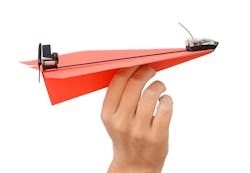July 29--OSHKOSH -- It's likely that soon after paper was invented, someone fashioned a sheet into a primitive flying machine.
Paper airplane creators who watched in dismay as their creation nose-dived into the ground or their third grade teacher's desk shook their heads and wondered -- what if I could control the plane and fly it farther?
At the EAA AirVenture, that dream has attracted crowds to the booth run by Toronto-based PowerUp Toys, a company that's a paper airplane kit that's controlled by smartphones.
Kits cost $50 and include four colored printed paper templates, a spare propeller and rudder, a tiny power pack that's charged with a micro USB cable and an app for smartphones for thrust and rudder control. Kits without the smartphone capability are $20.
Designers are working on adding more features to the smartphone app including a dogfight mode so paper airplane fliers can compete against each other. The app will soon include modes that will allow fliers to perform more rolls and dives.
"This is a throwback to a simpler time and people's childhoods," said Harold Chizick, PowerUp's vice president of marketing. "It also uses the best technology to make a product that enhances the senses. When they see the video people are like -- where have you been all my life?"
Company officials hoped to raise $50,000 through Kickstarter and were shocked when the goal was reached in the first eight hours. As money flowed in, averaging $80,000 per day, 21,000 backers ultimately ponied up $1.2 million.
"People immediately knew how magical this was," said Chizick.
The smartphone app version of the plane launched Monday and judging by the crowd around the PowerUp Toys booth in the Innovations Tent at AirVenture, it's a big hit among aviation enthusiasts. This is the first time the company has visited AirVenture.
David Ausman, 11, of Albuquerque, N.M. asked his mom Amy for $20 to buy the nonsmartphone version and grinned as she pulled out her wallet.
"I've seen it on the Internet and I actually wanted one. It's a coincidence that I saw it here," said David, adding that the furthest he's flown a paper airplane is 10 feet.
"He loves paper airplanes," said Amy Ausman.
The powered paper airplanes are the brainchild of Shai Goitein, who flew cargo planes and jets in the Israeli air force.
He figures he was around 5 years old when he made his first paper airplane. Several years ago Goitein wondered how he could make a powered paper airplane -- to turn a folded piece of paper from a glider whose propulsion was the muscles of whoever threw it, to something that could defy gravity, if only for a minute or so. He worked with two friends, one of whom is an aerospace engineer, to devise the first version.
"I love paper airplanes but when I thought of the potential of power, it was a 'Eureka!' moment," said Goitein. "I didn't think it would be this popular but I had a gut feeling people would love it."
The paper airplane flies at a speed of six yards per second and can stay aloft as long as a minute. The power module takes about 20 minutes to charge for a total of 10 to 12 minutes of flying time depending on wind conditions. The maximum range for the smartphone controls is around 70 yards.
The app is compatible with smartphones that have Bluetooth. The app looks like a flight simulator and includes a magnetic compass, artificial horizon and a small control panel that shows thrust level, throttle, signal strength, heading direction and battery charge level. Tilting the phone banks the plane and you can tap the control tower icon for simulated control tower announcements.
Wesley Taylor-Vincent, 15, and his father Monty Vincent stopped to ogle the powered paper airplanes and bought one with the smartphone app to take back home in Irving, Texas. Taylor-Vincent started making paper airplanes when he was 6 or 7. His longest flight? About the length of his classroom.
"I saw the project on Kickstarter and I thought it was a very smart invention. I wondered why someone hadn't thought of this before," he said.
For more information -- www.poweruptoys.com
Copyright 2014 - Milwaukee Journal Sentinel



